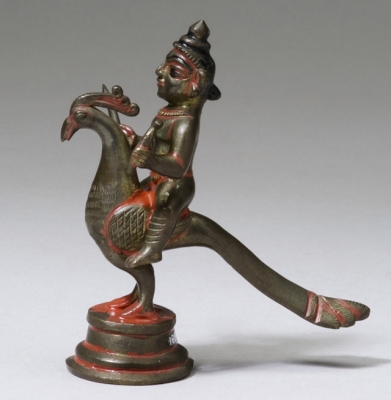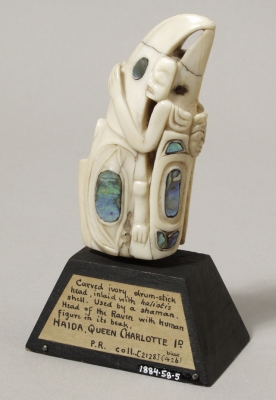To search the RPR site click here
Nature 23 and 30 September 1880
pp. 489-493 and 511-514
General Pitt Rivers' (Lane Fox) Anthropological collection
The collection which General Pitt Rivers, FRS, commenced to form in the year 1851 became well known to all immediately interested in the science of anthropology during the series of years which it was exhibited at the Bethnal Green branch of the South Kensington Museum as Col. Lane Fox's collection, and no one visited it without picking up a great deal of interesting and curious information. To those who studied it with care it opened up a new field of exploration, and invested all objects of art and manufacture, from the simplest ornaments, weapons, or implements of savages, to works the product of the highest modern culture, with a certain peculiar interest over and above the gratification derived from the objects themselves without reference to the history of their origin. It is needless to say that the moving power of this peculiar interest was the evolution theory, for the object which General Pitt Rivers set before him was, as he explained, 'so as to arrange his collection of ethnological and prehistoric specimens as to demonstrate, either actually or hypothetically, the development and continuity of the material arts from the simpler to the more complex forms. To explain the conservatism of savage and barbarous races and the pertinacity with which they retain their ancient types of art. To show the variations by means of which progress has been effected and the application of varieties to distinct uses. To exhibit survivals or the vestiges of ancient forms which have been retained through natural selection in the more advanced stages of the arts, and reversion to ancient types. To illustrate the arts of prehistoric times as far as practicable by those of existing savages in corresponding stages of civilisation. To assist the question of the monogenesis or polygenesis of certain arts; whether they are exotic or indigenous in the countries in which they are found. To this end objects of the same class from different countries have been brought together in the collection, but in each class, the varieties from the same localities have been placed side by side, and the geographical distribution of each class has been shown in distribution maps.' [No source given for this quote] The gradual growth of the arts has of course been the theme of many writers. But General Pitt Rivers was the first, and up till now has, we believe, remained the only, collector who has investigated the development of arts and manufactures, and brought home their history to students by means of series of the objects themselves arranged in groups so as to illustrate their actual pedigrees.
It is in the arrangement that the collection differs from all others. Very many of the objects of which it is composed are to be found in most ordinary ethnological collections, such as that in the British Museum, and the Christy collection; but in these the specimens are arranged geographically, and though thus serving a purpose of the utmost importance as showing in what matters of culture the various races of man are most clearly distinct and separate, or more or less allied, they do not afford that kind of information which it is the one aim of General Pitt Rivers' collection to convey and develop. In fact in the case of all series of objects of arts or manufactures two collections are absolutely required: the one to illustrate pedigree in accordance with the Darwinian theory, the other to illustrate geographical distribution. A collection arranged on General Pitt Rivers' plan is much needed in natural history galleries. What is specially required for the purposes of general instruction is a series which shall trace the pedigree of man and all the other highest types in the several groups as directly as possible from the lowest forms of life. Such a collection might be arranged in a series of galleries radiating from a central chamber in which should be placed the lowest forms, each gallery leading gradually up to the highest of the group to which it was allotted. Good models should represent in the series those links which are embryonic, or which require reconstruction from fossil remains.
Since the year 1851, when General Pitt Rivers' collection was first commenced, it has been continually added to, and it has now reached very considerable dimensions. The space allotted to it at present in the South Kensington Museum will not be sufficient to display it sufficiently. General Pitt Rivers has most generously offered to present it to the nation on certain conditions, which will insure its being properly maintained in its present arrangement, and prevent the possibility of its being broken up and distributed amongst those other collections by any future authorities who might not thoroughly comprehend its importance in its present condition. It is stipulated that General Pitt Rivers shall have the management of the collection during his lifetime, and that sufficient space shall be allotted to him to allow of his making additions and further developing it in accordance with the plans he has formed.
... there could be no better place for the collection than in the South Kensington Museum [now the Victoria and Albert]. It is, as it were, the key to the whole of the vast collections there gathered together. On the one hand, in the Pitt Rivers collection is traced the earliest history of inventions, showing plainly how every primitive implement and machine grew slowly from the simplest contrivances, thus leading up to and acting as a preliminary training for the study of the contents of the Patent Museum; whilst on the other is to be learnt the developmental history of all the arts, the gradual development of sculpture and painting, the history of the development of pattern ornaments, the growth of musical instruments, of the art of pottery, of clothes, and the history of the gradual development of ships. All these series and very many others lead directly up to the various large collections of paintings, sculpture, pottery, models of shipping, &c, which is the main object of the Museum to exhibit, and cannot but greatly enhance their value and interest to the student. They serve to impress upon the observer the curious fact that all arts and inventions, even those apparently of great simplicity, have never been arrived at by jumps, but have grown slowly by degrees by means of a series of slight modifications, just as in the case of biological development. The collection, it should be remarked, does not in any way clash with the Christy and British Museum collections, which are arranged on a perfectly different plan, and which do not in any way bring together savage and civilised objects. There is full room for both collections, and indeed a necessity for them.
We will now draw attention briefly to some few of the series of objects exhibited in the collection taken more or less at random as samples of the whole. The collection may be considered as consisting of three parts. Firstly, a collection of photographs of the various races of mankind which is not as yet far advanced, though it contains large and instructive series of portraits of Danes, Scandinavians, the people of Brittany, and Japanese; whilst together with the photographs is a small series of those skulls which show the best marked racial characteristics, and another which is to exhibit the various modifications in the forms of their skulls which are made by different races. Secondly, the very large collection showing the growth of weapons of all kinds.[The 1874 catalogue lists all the objects displayed at Bethnal Green in these first 2 categories]. Thirdly, the various series illustrating the development of musical instruments, ornaments, sculpture, painting and artistic design of all kinds; and fourthly, those which relate to the development of implements, utensils, houses, ships, machines, and strictly useful appliances of all kinds. Of course the two latter series run into one another, and it is impossible to draw a distinct line between them in the case of the lower terms of the series. ... We propose to give a slight sketch of some of the series in the collection, taken at random from its several departments, culling freely from the owner's published catalogue, and his papers read before the Anthropological Institute and elsewhere. We may state at the outset that there exists as yet a catalogue of the weapons only. General Pitt Rivers has not been able to complete a catalogue of the remainder of his collection, since it has been continuously in process of augmentation.The catalogue of the weapons contains so much valuable and curious information that the appearance of the remainder may be looked forward to with great interest....
The collection of weapons commences with weapons of offence, and begins with a series illustrating the development of the shield out of the parrying stick, such as now used by the Australian blacks, the idea of the wide shield covering the whole body having apparently arisen as an improvement on the simple stick held in the centre, which gradually expanded and grew into a shield ...
In conclusion we can only express a hope that the Pitt Rivers collection will be accepted by the nation on its generous donor's conditions, and we strongly recommend any of our readers who have not studied it to pay it a long visit at once, and profit by the varied fund of instruction and entertainment which it cannot fail to impart.
[Transcribed by AP as part of the 'Kent project' during the 1990s]





